Originally published in Hana Hou!, January 2023
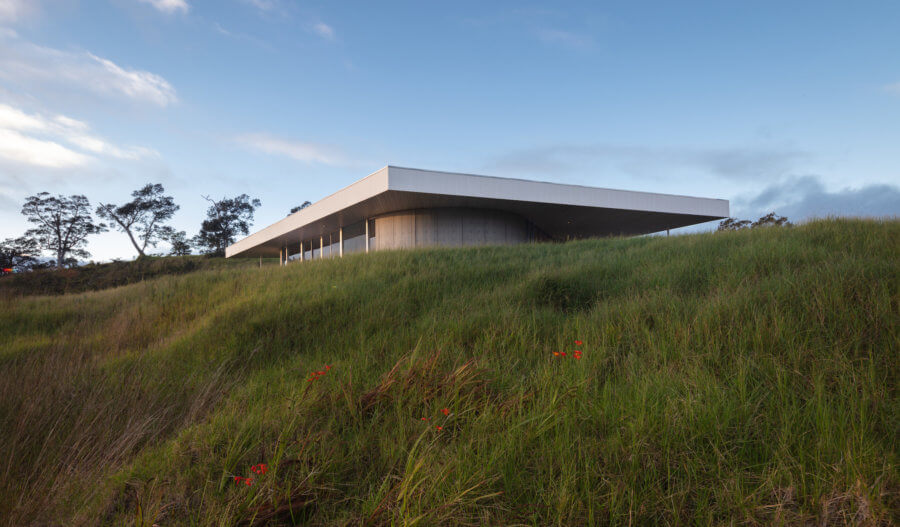
If asked where the epicenter of Hawai‘i‘s architecture and design scene is located, the obvious answer would be Honolulu. Where else can a person have lunch in a Julia Morgan-designed café? Or soak up skyline views from mid-century master Vladimir Ossipoff’s Liljestrand House? Or bask in the Brutalist beauty of Victor Gruen’s Financial Plaza of the Pacific, a concrete sculpture the size of an entire city block? And yet for all of the city’s offerings, some of Hawai‘i’s most original architecture over the past twenty years is not in Honolulu but two hundred miles southeast, in the verdant, violent wilds of Hawai‘i Island.
Here, amid fields of pahoehoe lava and old-growth ‘ohi‘a forest, 58-year-old architect Craig Steely has been building a portfolio of bold, unapologetically modern houses, no two of which are alike. Some seem to float in the forest canopy; others hide in plain sight—simple boxes that belie the dynamic interplay of light and shadow taking place inside. Some look like spaceships fallen from the sky. What unites them is their sensitivity to place; Steely’s work eschews the stereotypical hallmarks of contemporary Hawai‘i architecture—double-pitched roofs, Polynesian patterns, black basalt— responding instead to the land and history of the Islands in ways that are not always immediately apparent.
“I’m interested in projecting in my work deeper connections to Hawai‘i,” Steely tells me. “Some laser-cut sunscreen that looks like an ‘ulu [breadfruit] is just embarrassing.”
“He’s not trying to do something that looks like it belongs in Hawai‘i, as an aesthetic or a form. He’s designing spaces that [work] in Hawai‘i,” says Graham Hart, assistant professor of architecture at the University of Hawai‘i at Manoa and cofounder of the boutique design firm Kokomo Studio. Hart first saw Steely’s work while a student at UH. He admired the architect’s restraint. Spatially, the houses were simple yet sophisticated. They nodded to midcentury modernism and other styles without feeling derivative or dated. They were one of a kind.
“If you were to put together a list of the best architecture to come out of Hawai‘i in the past decade, the top five would have at least one or two Craig projects on it,” Hart says. At the same time, the place Steely occupies in Hawai‘i’s design scene is, like each of his houses, unique, Hart says. “A hundred years from now, or whenever we start doing retrospectives on contemporary Hawai‘i architecture, I think he’s gonna be in his own box.”
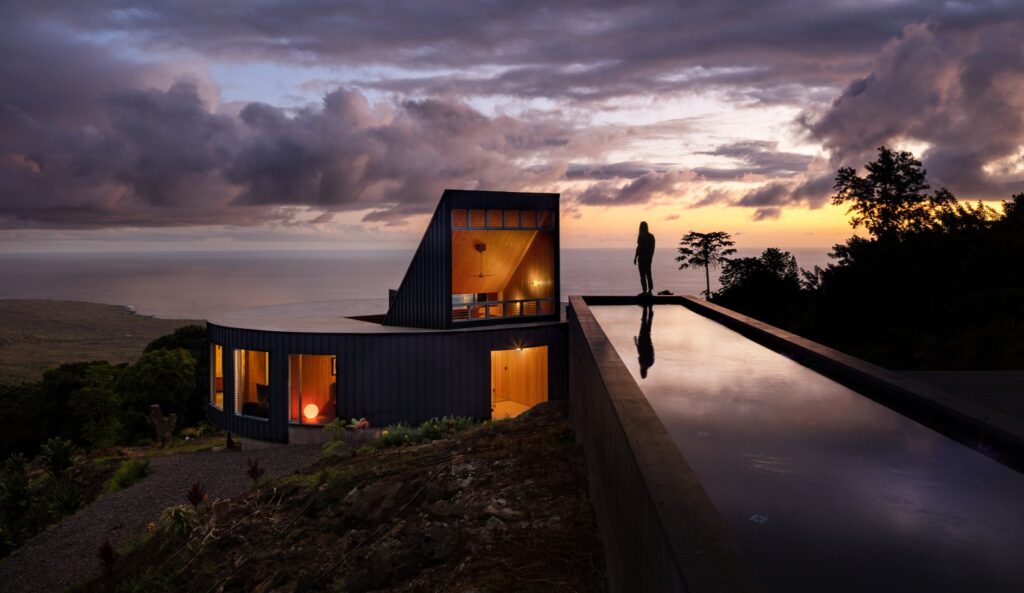
Steely grew up on a walnut orchard in the foothills of the Sierra Nevada. He remembers his childhood house as an ever-changing amalgamation, perpetually under construction to meet the family’s needs. “It was always being added onto,” Steely says. “The entry room became the dining room. The kitchen expanded into the garage, which became another living room.” Like their friends and neighbors, his parents did much of the work themselves. “Everyone built their own houses. You needed a barn, you just built it.”
Steely was 13 or 14 when he discovered capital-A architecture on a family fishing trip up the California coast from Bodega Bay. From the water one day Steely spotted a group of odd wooden buildings with sloping roofs, each seeming to flow into the other. It was as if they had been there all along, he thought, shaped by the same elemental forces as the rugged shoreline. “They looked like rocks just sitting out in the grass,” he recalls. It was Sea Ranch, the famous early environmentalist community developed in the early 1960s by a coterie of the era’s leading designers. The development was radical at the time for its ecological sensitivity; buildings worked in concert with the terrain, and most of the 3,500-acre property was left undisturbed. It set—and in some ways remains—the bar for inserting architecture into a sensitive landscape.
It was on the same trip that Steely came across a copy of Sunset magazine. He’d already started drawing houses—quick sketches of rooflines and forms in his spiral notebook—but flipping through that issue, he had a life-changing realization: There were people who just designed houses. “It was like, wait a minute, this can’t be real,” he says.
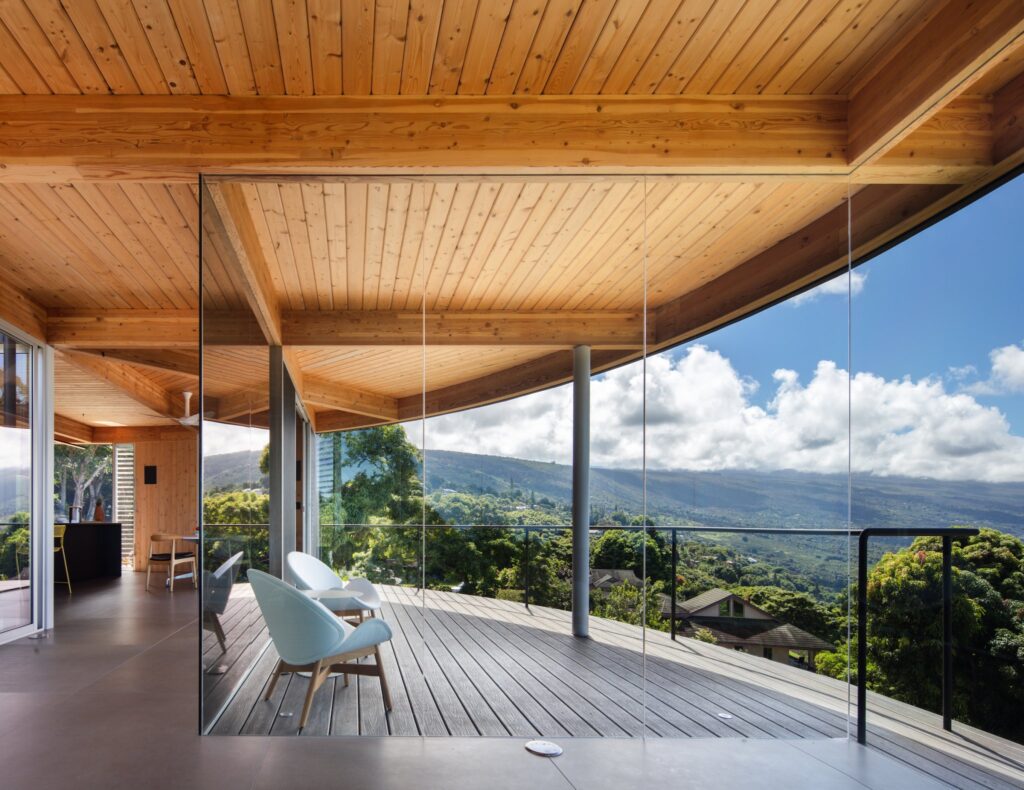
When the teenage Steely wasn’t sketching—which his mother, a painter, encouraged—he was learning how to soup up cars from his father, whose own father owned a garage in nearby Clements. Similar to his family’s ever-evolving house, building hot rods taught Steely that there wasn’t much in the world you couldn’t change “to make it more the way you wanted it to be,” he says. “You could do that with anything. You could do that with a tractor. You could do that with a house. You could tailor anything to exactly the way you wanted it to be. Nothing was sacred.”
It’s a lesson Steely has applied to his career. After architecture school and a stint working in Italy—where he met his wife, artist Cathy Liu—he moved to San Francisco in 1990, where Liu was living. He had little trouble finding a job, he says, but quickly soured on the long hours and lack of creative freedom. He was fired more than once. Steely considered leaving architecture altogether and pursuing sculpture, but then he’d take a side gig—designing a set for a fashion show or some other unconventional project—and remember how much he loved it. “I kept being dragged back,” he says. “At some point I realized that I’d been fired from the best architecture offices in San Francisco, so I wasn’t going to get back into architecture that way. I had to do it my own way.”
That meant starting—and staying—small. He opened a practice and did projects for friends. He saved money by being his own builder. “I would design something, and the contractor would say, ‘That’ll cost $30,000,’ and I would say, ‘I can do it for $20,000.’” Thirty years later Craig Steely Architecture is still mostly a one-man shop (at most Steely employs one or two other designers). He’s selective about clients and, with the exception of a ramen restaurant in San Francisco, exclusively designs houses.
He owes at least part of his success to a combination of punk-rock charisma and childlike enthusiasm. “Picture the stereotypical surfer from San Francisco—you know, a little bit hippie, a little bit hipster, but with an encyclopedic brain,” Hart says. Indeed, conversations with Steely, who, with shoulder-length hair and a uniform of jeans and vintage t-shirts already looks more like a pro surfer than an architect, tend to be riddled with references to obscure music, books and films and peppered with big ideas. The first time I met him, at the Kaimana Beach Hotel on O‘ahu, he saw my voice recorder and began excitedly telling me about the time he bought one to make field recordings, which spiraled into a discussion of archives, entropy and the nature of time. It’s as if he never shed that teenage part of himself that unselfconsciously thrills at discovering new things. “He’s just so engaged in the moment,” Hart says. “He never runs out of energy. I’ve never seen him tired.”
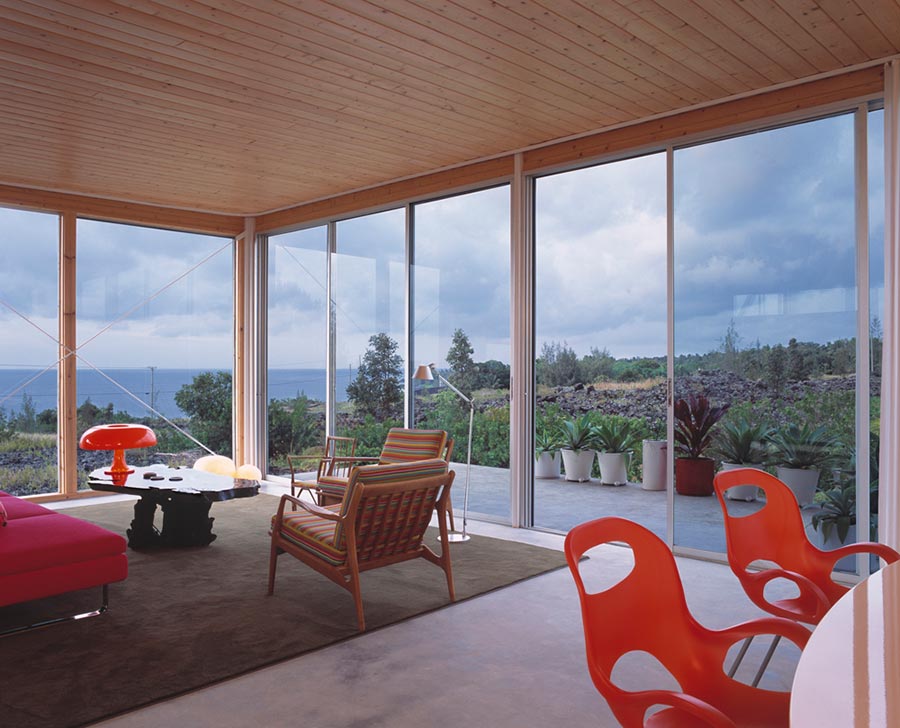
In 1998, Steely flew to Hawai‘i for the first time. He’d been hired to design a house near Pahoa on Hawai‘i Island, and on his way out to the building site, he stopped at Pohoiki, the popular beach park and surf spot that was later destroyed during the 2018 volcanic eruption. “I remember pulling up, and there were people fishing and surfing and swimming and camping, and instantly I felt incredibly attracted to this place,” he says. The more time he spent on Hawai‘i Island, the more it reminded him of the Sierra foothills. “It was really rural, and you knew your neighbors because you had to depend on them when things broke down. There was just that sense of connection that people had to the land—and to each other,” he says.
Less than a year after beginning that first house, Steely and Liu bought a small property in Kalapana on which he built a modest residence that’s somewhere between a 1960s glass house and a Hawai‘i-style bungalow, with cantilevered rooms and floor-to-ceiling glass but also a corrugated metal roof and jalousie windows. The blessing for the house and the lu‘au for their son Zane’s first birthday took place the same day. Neighbors came to help cook. “We felt so instantly included in the community down there,” Steely says. He and Liu have split their time, more or less fifty-fifty, between San Francisco and Hawai‘i Island ever since.
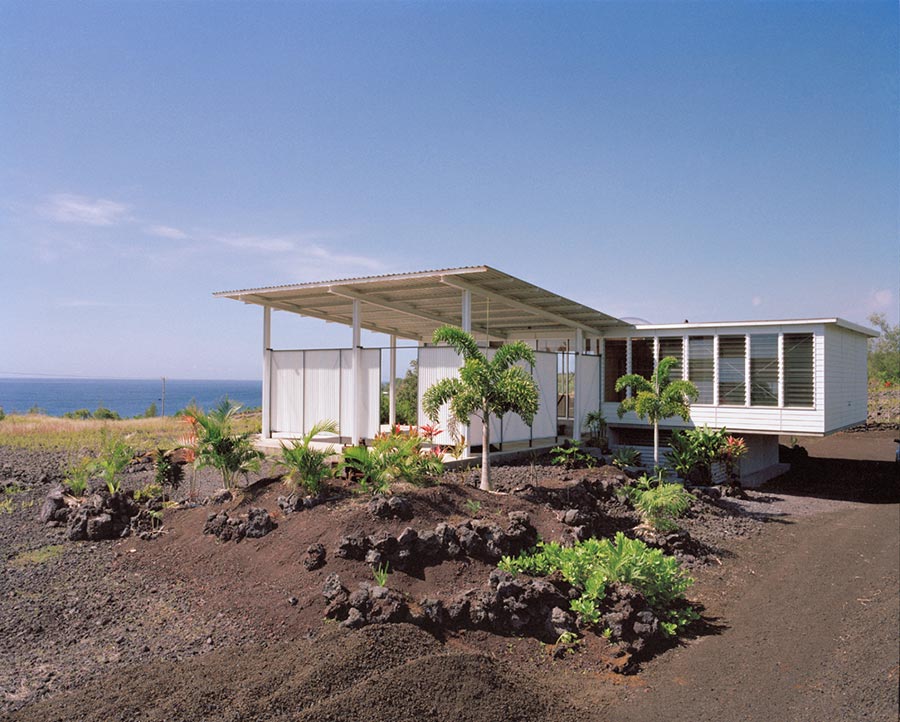
Ask Craig Steely about a house he designed and he’ll start by telling you everything else: about the site’s mercurial weather, the subtle variations in topography that create eddies of wind and fog, how these inform where he puts a house. Or how he bonded with a client over their shared love of German composer Klaus Schulze and the playlist they ended up making for the project, all droney synths and pulsing beats, the juxtaposition of sci-fi soundscapes made with analog recording equipment seemingly a metaphor for the house itself.
It’s all a part of Steely’s sponge-like creative process. Most often it begins with the land. He makes repeated visits to building sites, trudging through the rainforest or picking his way over expanses of lava, sensing where the slope changes, where the light shifts, where the views begin to open—all before he draws a single line. To Steely a house should connect a person to the environment, not separate them from it. A house, he says, should be secondary to the land it sits on. “It’s another client, in a way,” he tells me.
Architecturally, Steely’s houses have little in common with the kinds of high-end luxury residences one sees throughout Hawai‘i, most of which share a handful of stylistic touchpoints. Steely’s houses, in contrast, are specific and idiosyncratic in their influences. They respond not to a vague, nostalgic idea of “Hawaiianness” but to what it means to live right here, right now. “Modern Hawai‘i’s culture is amazing,” Steely says, describing it as a panoply of Oceanic and Pacific Rim cultures that “still holds the best of the old.” For him, the idea that Hawai‘i architecture can be reduced to something visual is “completely lame and inappropriate.”
Hart recalls a lecture Steely gave at UH, which began with photos of run-ofthe-mill carports in Manoa. “He talked about the ‘carport vernacular’ rather than the lanai,” Hart says. “Because a lot of homes don’t have properly designed lanai, but a lot of them have carports that everyone kind of lives in. And I think that understanding, like, ‘I’m not going to do something that’s referential to the Hawaiian archetype; I’m gonna do the thing that people live in, the lifestyle’—that’s what he’s designing for.”
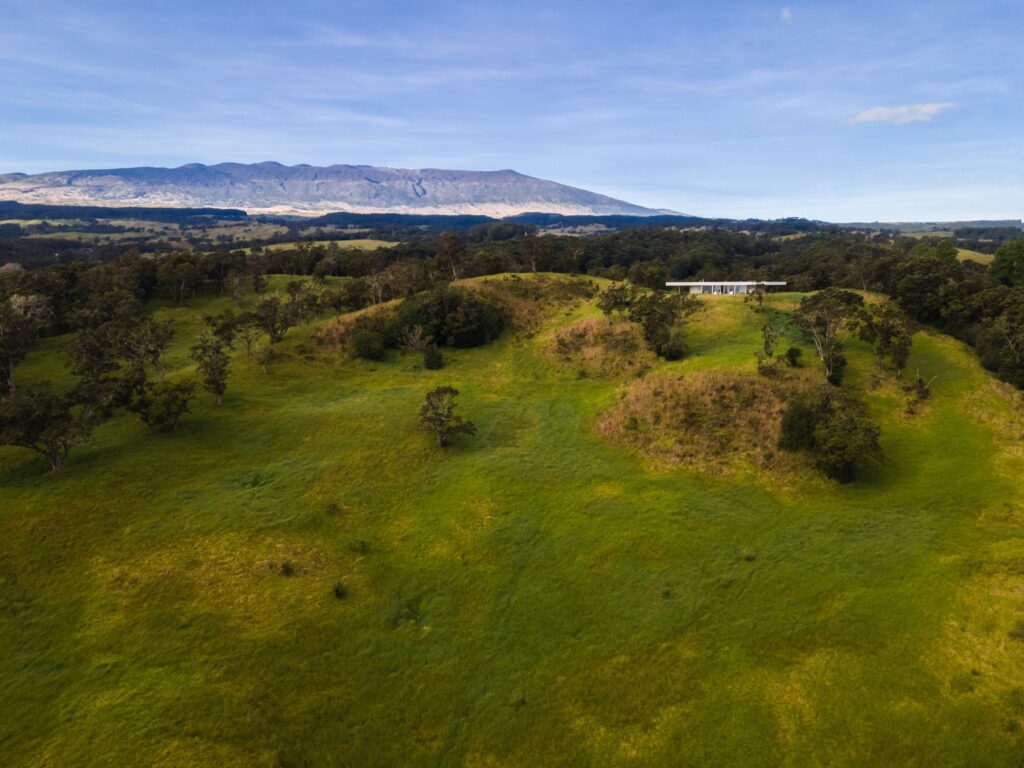
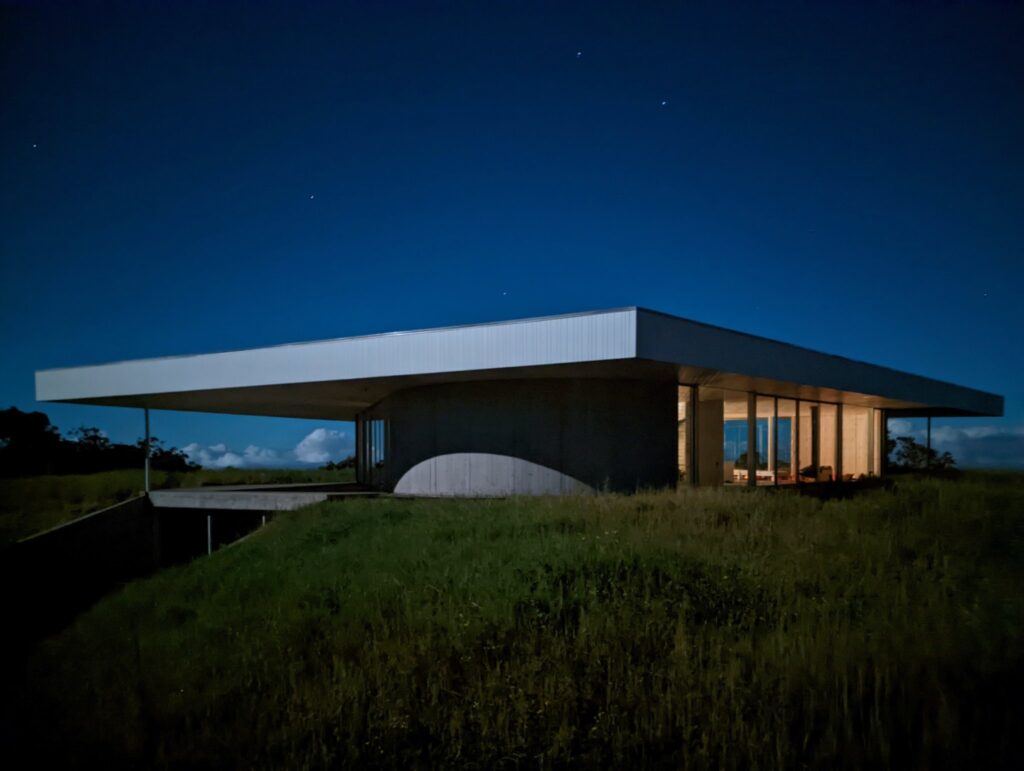
Steely’s latest project, his ninth on Hawai‘i Island, is the 2,200-square-foot Musubi House, so named for its roundcornered triangular floor plan. Guy Brand, the house’s owner, says Steely spent countless days at the property, which sits about four thousand feet above sea level on the Hamakua Coast, walking every square foot of its hundred acres over several years. “One time, Craig went up on his own, and there was a storm. There was a river running through the place, and he was wading through it,” Brand recalls. “I thought he would have said, ‘Yeah, f**k this place.’ Instead, he calls and goes, ‘Oh, man, this is gonna be great!’ His son, Zane, almost got washed away. But that didn’t stop Craig.
“Over the course of two or three years, he got to know us, and he got the vibe of what we liked. Then, one day, a sketch comes over. And it’s like, ‘Here’s your house.’ I was like, holy s**t!”
The sketch showed an equilateral triangle nested inside a much larger triangle, forming three spacious rooms organized around a central courtyard. The sides of the outer triangle would be glass, while their vertices would be cast-in-place concrete, and the whole thing would be topped by a monumental, diamond-shaped roof that would extend past the enclosed parts of the house to form multiple covered lanai. To Steely it was the only appropriate response to a place so dynamic. “On sites so powerful, how can you compete with it? You can’t,” he says. “So you make something that’s specific and its own thing.”
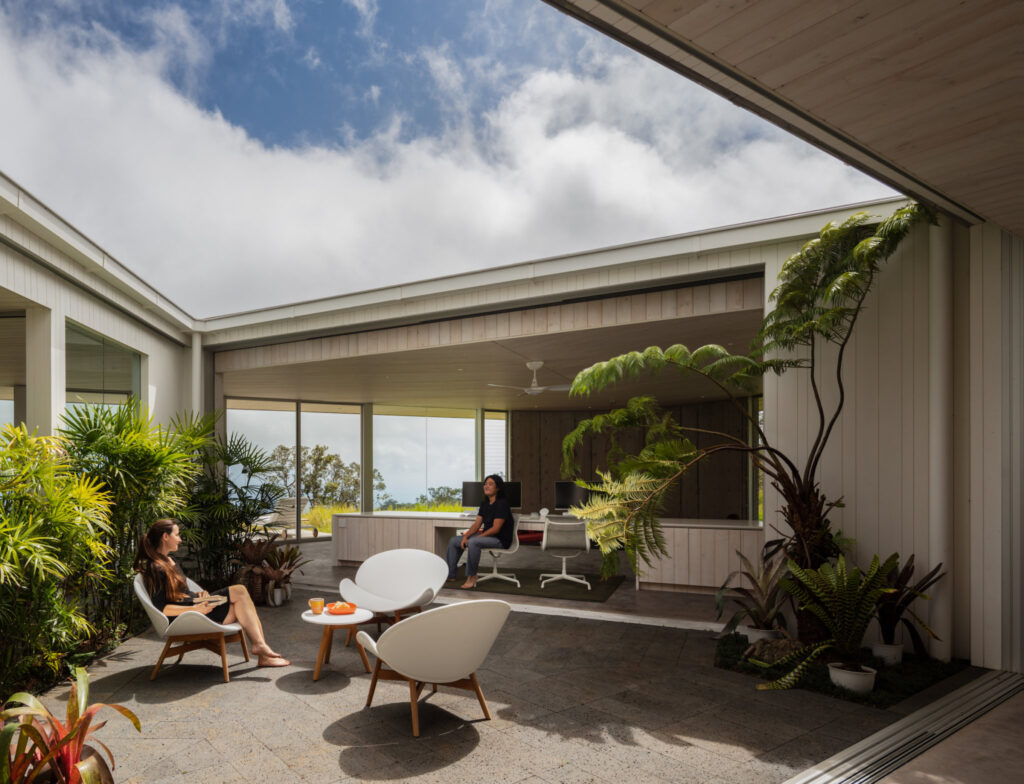
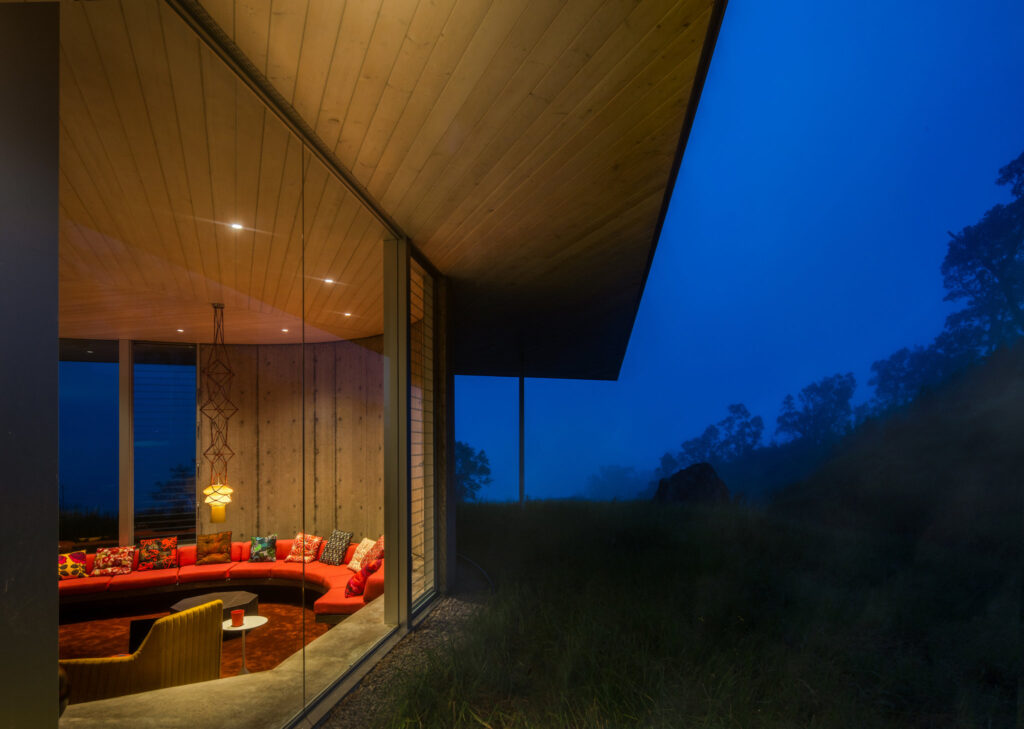
The unusual geometries have a purpose. On his visits, Steely had seen how rapidly the weather can change at that elevation. “There are times when the rain is coming horizontal and the fog is [super thick], and then other times it’s so clear and still,” he says. The house, which is completely off-grid, is sited so that its ocean-facing corner deflects the prevailing trade winds, much like the prow of a ship slices through the water. At the same time, Steely wanted to capture and even amplify the everchanging atmospheric conditions. He made the glass walls of the courtyard fully retractable, allowing whatever is happening outside to permeate the house. “I know it sounds crazy,” Steely says, “but the house really is designed to create a weather system within.”
Crazy or not, Brand has embraced this aspect of the house. “Sometimes it’s just raining in the house, and I love it,” he says. He texts me photos to prove it. Then he sends one of a wild boar on the lanai.
As futuristic as the Musubi House feels, it is intimately connected to the Hamakua landscape, embodying many of the same principles Steely saw in Sea Ranch all those years ago. “It’s like the whole hill is part of the house,” Brand says.
Despite Steely’s successes over the past decade—he’s been featured in magazines like Dwell, named a top residential firm by the American Institute of Architects and is currently at work on a book of his houses—the designer is nowhere near the pinnacle of his career. For one, he’s still young. Architect years are like dog years, but in reverse. Being 50 years old and an architect is like being 35 in any other profession; at age 60 many architects are just beginning to enter their prime. “Architecture is a long game,” Steely says.
Steely tells me that the worst part of being an architect is that all of your half-baked ideas are on display. “You leave this trail of ideas that you thought were so great, then you look back at it and you’re like, ‘Oh my god, what was I thinking?’” Steely has evolved over the course of his career, as have his houses. And yet, he says, sometimes it feels like he’s chasing the same elusive ideas. “I see one project, just different iterations on it.
Steely hasn’t tired of the chase. All these years later, he gets the same thrill from designing. He’s still that kid flipping through a Sunset magazine, sketching houses. “Some people are good at singing, some people are good at ballet,” he says. “I feel like architecture is the best way that I can express myself. I’m still finding inspiration from it. I feel like it’s getting better and better.” 🌾